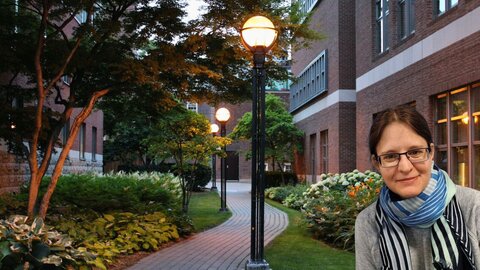My American dream

By Roman Höllwieser
A little over three years ago, I decided to apply for an Erwin-Schrödinger Fellowship in order to broaden my professional horizon by working abroad. The choice of research venue actually arose somewhat by chance as I happened to know a colleague who worked in the same field at the New Mexico State University (NMSU). At a meeting we initiated the collaboration that provided the basis for my Schrödinger project.
Why New Mexico, why Las Cruces?
I have to admit that I had never heard of Las Cruces, New Mexico, before. All I knew was that it certainly wasn’t anyone’s dream holiday destination. This said, the many trips and stays abroad I had enjoyed during my studies and post-doc time had taught me that unknown destinations always held more fascination for me than the grand metropolises on this planet. Accordingly, I was intrigued by the prospect of discovering what this unfamiliar place held in store for me. In what follows I am happy to present a region nicknamed the ‘Land of Enchantment’ which certainly made me fall under its spell.
Welcome to the Land of Enchantment
New Mexico is a federal state in the southwest of the USA, about four times the size of Austria but relatively sparsely populated with only two million inhabitants. Approximately 70,000 people live in Santa Fe, the state capital and third-largest city after Albuquerque (500,000) and Las Cruces (100,000). Santa Fe is the USA’s oldest state capital with settlements established there by indigenous people going back as far as the 12th century. New Mexico is the western neighbour of Texas and its landscapes are typical of Wild-West country. Situated on high plains, New Mexico is characterised by barren prairie land, with the foothills of the Rocky Mountains to the north and the Chihuahua desert in the south. Long before the Spaniards first arrived, this region was occupied by pueblo tribes. Later, it was home to notorious figures such as the outlaw Billy the Kid, who was destined to find his death on the gallows in Old Mesilla, today a district of Las Cruces. The Apaches, a Native American tribe well known to the readers of Karl May’s Winnetou novels, roamed the high plains of the state and watered their horses at the mighty Rio Grande which traverses New Mexico from north to south. Other popular features from Karl May’s novels to be found in New Mexico are the Llano Estacado (or Staked Plain), hunting ground of the fearsome Comanche tribe, and the mythical Silver Lake.
Sunset treasures
Although I did not discover a trove of gold on one of my numerous discovery trips through Native American territories, I had the unique opportunity to sit around a camp fire with Mescalero Apaches, the tribe of the great fictional chief Winnetou, eating their BBQ, experiencing their traditional songs and dances and spending the night in their wigwam village. The real treasure of this wonderful countryside reveals itself every evening when the setting sun weaves its magic on the landscape and paints the sky in breath-taking hues of gold! New Mexico has an average of five days of rain per year and uninterrupted sunshine nearly every day, so this glorious evening display became one of the fixtures in my daily routine. Apart from the countless truly good friends I have been lucky enough to find here, the sunset is probably what I am going to miss the most.
National monuments
New Mexico abounds with attractions, both natural monuments and relatively well preserved historical sites. The Carlsbad Caverns (giant dripstone caves), the Gila Cliff Dwellings (cliff dwellings of the Mogollon People dating back to the first century AD and thus historical precursors of the pueblo culture) or the snowy white sand dunes of White Sands behind the Organ Mountains, the local mountain range east of Las Cruces, are among the many national monuments I have been fortunate enough to visit in the past three years.
Roadrunner and Green Chile Cheeseburger
New Mexico’s state bird is the roadrunner, seen crossing the roads as frequently as the tumbleweed (or rolling bush). Add to that coyote sightings and, particularly, the nocturnal howling of a pack of coyotes, and you have the perfect Wild-West atmosphere. Rattlesnakes, desert scorpions and tarantulas as well as the black widow spider are less popular, but no less fascinating, inhabitants of New Mexico. Red and green chile peppers may not be as beautiful to behold as the flower of the yucca palm, the state plant of New Mexico, but the scent wafting across large parts of the country (including Las Cruces, I am happy to say) during the harvesting and roasting of chile peppers is no less enticing. The zesty hot flavour they give to juicy enchiladas, crispy tacos and hearty burritos has ensured New Mexican cuisine’s fame far beyond its boundaries. Although some people here proudly maintain their versions are better than the originals from neighbouring Mexico, I am reluctant to commit myself on this point, but will simply add the unique ‘Green Chile Cheeseburger’ to the list of noteworthy culinary treats.
Typically USA
New Mexico is typical of the USA in many respects. American football and baseball are the No. 1 sports, followed by basketball and ice hockey. As in the neighbouring state of Texas, carrying a handgun is considered normal, with many people tucking their colts openly into their belt. Having a weapons arsenal ranging from pocket handguns to semi-automatics at home is as natural as owning plates and cutlery. While the gap between rich and poor is made almost glaringly obvious by the parallel existence of gated living areas for the rich and shabby trailer parks, both sides accept that situation in pursuit of the ‘American dream’.
Spaceport America, aliens and the atomic bomb
In some respects, however, New Mexico looks very different from the conurbations on the East and West Coasts or the Great Lakes. The consistent use of the historical adobe construction style distinguishes particularly Santa Fe and Albuquerque from the otherwise uniform urban fabric of US cities. Albuquerque has achieved world fame with the launch of Breaking Bad, a television series whose admittedly crass images and dark humour portray a reality that is omnipresent around here. The border town of El Paso-Juarez, half an hour’s drive to the south of Las Cruces, is still one of the most important hubs for drug smuggling from Mexico to the USA. Gang wars and shoot-outs are almost daily occurrences there, and these disputes regularly lead to violent clashes at other stops along the drug routes, including Las Cruces and Albuquerque. Albuquerque is also the venue of the world’s greatest Balloon Fiesta, an annual gathering that sees more than 500 hot-air balloons in myriads of shapes and colours rise against the bright blue sky. We will probably never know whether the UFOs sighted in Roswell in eastern New Mexico were just hot-air balloons gone astray, but the supposed encounters with aliens and the myth surrounding the top-secret Area 51 have certainly turned that little town into a well-marketed mecca for science-fiction fans.
Thanks to the stable weather situation, New Mexico is not only home to the world’s first commercial spaceport called ‘Spaceport America’, but also to a research centre by NASA established in the vicinity of the spaceport. The White Sands Missile Range, a restricted military rocket range amid the white sand dunes, is not quite as secret as Area 51. Rocket and bomb tests are common occurrences in this test site covering 8500 square kilometres. The history of bomb testing started in the 1940s, when the world’s first atomic bomb was detonated after years of development at the National Labs of Los Alamos in the north of New Mexico. ‘Trinity Site’, the bomb crater where the detonation took place, is made accessible to the public once a year. I, too, consider it a warning as to how careful one has to handle new research results, particularly in the field of nuclear physics. After a lengthy excursion through the Land of Enchantment, this takes me to the real reason for my research stay - physics!
My American dream
With around 40 staff and about twice as many students, the Department of Physics at the New Mexico State University is almost a family business, and I was welcomed there with open arms. With its numerous co-operation projects, the small nuclear physics research group has provided me with a host of new scientific methods and a lasting network for future research ventures. The beautiful campus of the NMSU in the south of the small but pleasant town of Las Cruces offers a lovely working climate, and I was able to achieve my research targets in co-operation with nice and friendly colleagues. In addition, I was able to gather experience in working with students in smaller research projects and classroom work. In short, I have never regretted my decision to come here. The support from the FWF has enabled me to live what may not be everybody’s dream but was certainly my American dream!
More Information





